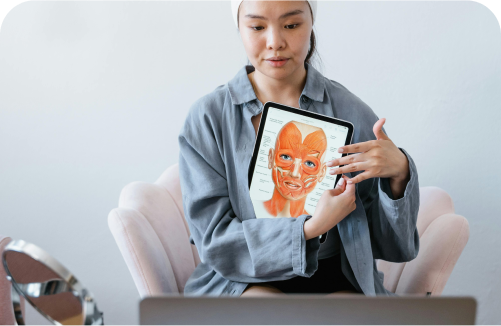NCR Online Course

During the first six three-hour Zoom classes of the NCR Course, Dr. Howell will talk to you about the concepts he has clinically derived to explain the integration of the muscles, bones, and tendons—a lot. They are the basis for NCR. Our primary intent is to help you to develop your understanding of the way that all physical medicine treatments integrate with body structures. Once you understand that, you will have a tool to evaluate any and all treatment protocols. Most treatments do not work because they do not address these situations effectively. These are all clinical observations, so you could eventually figure everything that Dr. Howell has developed---only if you understand the concepts and then apply your knowledge of anatomy and physiology to them.
In this NCR Course you will also be shown how to perform all of the essential skills of NCR: how to set up endonasal equipment, how to insert the instrument into the three sets of passageways leading from the nostrils to the throat, how to position the patient, how to hold the inflating instrument in your hand, how to support the head with your other hand, and how to inflate the endonasal balloon with its inflation bulb. You will also be shown the bodywork techniques included in the basic NCR treatment. There will also be descriptions of the potential problems, areas of difficultie with administration of the treatment, the conditions that we treat with NCR, and how we are blending NCR with other therapies. All of this will be demonstrated online, of course. We recommend that you attempt as much of these methods as you can arrange with a volunteer. We have found that few people successfully perform this treatment well without live, hands-on training. You can join us later for a five-day, hands-on class.
Class 1 NCR treatment concepts:
- Why don’t most treatments last?
- Our bodies’ stabilization of structures,the role of scarring and adhesions
- Pain, fibrosis, and scarring
- The quest for symmetry and beauty
- The brain needs stability!
- body needs stability!
- Stability creates a safe haven for healing
- Symmetry without scarring and fibrosis creates high functionality
- The perfection of structure leads to perfect functioning
- How to demonstrate stability and instability
Class 2 Endonasal equipment and their setup:
- Why we use water soluble compounds
- Why we use analog equipment
- There are limits to hygiene
- Attaching a latex balloon to your sphygmomanometer bulb
- Nasal anatomy
- Turbinate or concha bones separate the meati
- The nasal septum is made up of cartilage and the vomer
- The vestibule is the space where you can put your finger
- The ventral surfaces are the most sensitive to your equipment’s touch
- The six pathways that fluids or nasal balloons follow go from the vestibule of the nostril into the nasopharynx
Class 3 Exploring your nose and the nasal pathways from the nostril to the nasopharynx:
- The inferior pathway is the straightest and largest
- The middle pathway is shaped like the letter J
- The superior pathway is shaped like the letter V
- Pushing a latex balloon from your nostril into your own throat.
- Inflating the sphygmomanometer bulb while the balloon is attached.
- Why we use an endonasal bulb and how to position it in the nostril and throat for treatment.
- Inserting an endonasal balloon into a moving target (your Member’s jumping, wiggling, and moving nose).
- How do we adjust the pressure the equipment generates?
- When you are changing structures in the head, what are the effects of different intensities of pressure?
- Try to insert balloons into your volunteers’ noses.
Class 4 Hand placement to prevent balloon slippage and loss of traction:
- A balloon doesn’t want to stay inflated in the nose
- Proper hand positioning is essential to have the balloon’s path of least resistance lead into the throat
- What about nasal polyps?
- Too much air in the balloon forces it out of the mouth.
- Too weak a balloon cannot move the bone.
- Potential problems during and after the treatment
- Epistaxis
- Try your skills inserting balloons on your volunteers’ again
Class 5 How many treatments does a Member need?
- Why do we cluster treatments?
- Management of complex conditions
- Subject management before, during after, and between treatment series
- Try your skills inserting balloons on your volunteers’ again
Class 6 Liability concerns, expected results, objective demonstrations of results
- Epistaxis, shock, bruising, sore throat, balloon won’t deflate
- What fees are commonly charged for NCR? Are there Insurance codes?
- Have you tried inflating the balloon in your volunteers’ noses?
There will be an exam at the end of the sixth class. You must past this exam if you want to join the hands-on NCR Course.